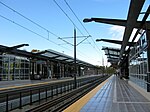Sick's Stadium

Sick's Stadium, also known as Sick's Seattle Stadium and later as Sicks' Stadium, was a baseball park in the northwest United States in Seattle, Washington. It was located in Rainier Valley, on the NE corner of S. McClellan Street and Rainier Avenue S (currently the site of a Lowe's hardware store). The longtime home of the Seattle Rainiers of the Pacific Coast League (PCL), it hosted the expansion Seattle Pilots during their only major league season in 1969. The site was previously the location of Dugdale Field, a 1913 ballpark that was the home of the Rainiers' forerunners, the Seattle Indians. That park burned down in an Independence Day arson fire in 1932, caused by serial arsonist Robert Driscoll. Authorities would later claim that Driscoll was one of the most dangerous arsonists in the United States during the Great Depression. Until a new stadium could be built on the Dugdale site, the team played at Civic Field, a converted football stadium at the current location of Seattle Center's Memorial Stadium.
Excerpt from the Wikipedia article Sick's Stadium (License: CC BY-SA 3.0, Authors, Images).Sick's Stadium
Rainier Avenue South, Seattle Mount Baker
Geographical coordinates (GPS) Address Nearby Places Show on map
Geographical coordinates (GPS)
| Latitude | Longitude |
|---|---|
| N 47.58 ° | E -122.298 ° |
Address
Rainier Avenue South
98144 Seattle, Mount Baker
Washington, United States
Open on Google Maps








